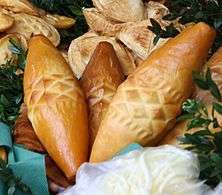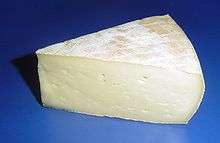Brined cheese

Brined cheese, also sometimes referred to as pickled cheese for some varieties, is cheese that is matured in a solution of brine in an airtight or semi-permeable container. This process gives the cheese good stability, inhibiting bacterial growth even in warmer climates.[1] Brined cheeses may be soft or hard, varying in moisture content, and in colour and flavour, according to the type of milk used; though all will be rindless, and generally taste clean, salty and acidic when fresh, developing some piquancy when aged, and most will be white.[1]
Washed-rind cheeses are periodically cured in a solution of saltwater brine and/or mold-bearing agents that may include beer, wine, brandy, and spices, making their surfaces amenable to a class of bacteria Brevibacterium linens (the reddish-orange "smear bacteria") that impart pungent odours and distinctive flavours, and produce a firm, flavourful rind around the cheese.[2]
Brined cheeses
Many varieties of brined cheeses are produced. Varieties of brined cheese include feta, halloumi, sirene and telemea, a variant of brinza.[1] Brined cheese is the main type of cheese produced and eaten in the Middle East and Mediterranean areas.[3]




Additional brined cheeses include:
- Abbaye de Tamié
- Akkawi is a white brine cheese named after the city of Acre in Israel. It is commonly made using cow milk, but can be made with goat or sheep's milk as well.
- Alpujarra cheese
- Appenzeller cheese
- Ardrahan Cheese
- Some varieties of Asiago cheese are brined.
- Balkánský sýr is a white brined cheese produced in Czech Republic and Slovakia. It is a salty semi-hard white cheese, and is analogous of the Bulgarian sirene and the Greek feta.
- Beaufort cheese
- Berner Alpkäse
- Bondost
- Cantabrian cream cheese
- Caprino di Cavalese
- Chechil is a brined string cheese that originated in Armenia and Anatolia.
- Cherni Vit
- Corleggy Cheese
- Dovedale
- Egyptian cheese
- Hâlûmi resembles Cypriot halloumi, but is a different cheese. It may be eaten fresh or brined and spiced. The name comes from the Coptic word for cheese, "halum".
- Some varieties of goat cheese are brined prior to the aging process.
- Gruyère cheese
- Halloumi
- Herrgårdsost
- Ibores is sometimes brined in its production.
- Leyden
- Lighvan is a brined curd cheese traditionally made in Iran. Having a sour flavor, and a shape covered by holes, the cheese is produced from sheep's milk.
- Mallorca cheese
- Maredsous cheese
- Maredsous Abbey cheese
- Mozzarella is sometimes brined.
- Murcian cheese
- Murcian wine cheese
- Munster cheese
- Nabulsi is one of a number of Palestinian white brined cheeses made in the Middle East.
- Oka cheese
- Oscypek
- Pallone di Gravina
- Parmigiano-Reggiano is brined in its production process.
- Pasta filata is sometimes stored in brine, which enables preservation and for the product to be shipped.
- Pecorino Sardo
- Red Hawk cheese
- Saint-Nectaire
- Svecia
- Sulguni
- Swaledale
- Telemea
- Teviotdale cheese
- Tulum is a traditional brined Turkish goat's milk cheese ripened in a goatskin casing, called tulum in Turkish.
- Tzfat cheese
See also
References
- 1 2 3 A. Y. Tamime. Brined cheeses. Wiley-Blackwell, 2006. p. 2. Retrieved 21 March 2011.
- ↑ Washed Rind Cheese at Practically Edible Food Encyclopedia
- ↑ A. Y. Tamime. Feta and Related Cheeses. Woodhead Publishing, 1991. p. 9. Retrieved 21 March 2011.
Further reading
- Tamime, A.Y (2008). Brined Cheeses. John Wiley & Sons. ISBN 1405171642.
- Dariani, Davood Nadjarian (1979). A Chemical, Sensory and Consumer Evaluation of Soft Pickled Cheese Manufactured from Cow and Goat Milk. University of Georgia.
External links
-
 Media related to Brined cheese at Wikimedia Commons
Media related to Brined cheese at Wikimedia Commons -
 Media related to White Brine Cheese at Wikimedia Commons
Media related to White Brine Cheese at Wikimedia Commons
